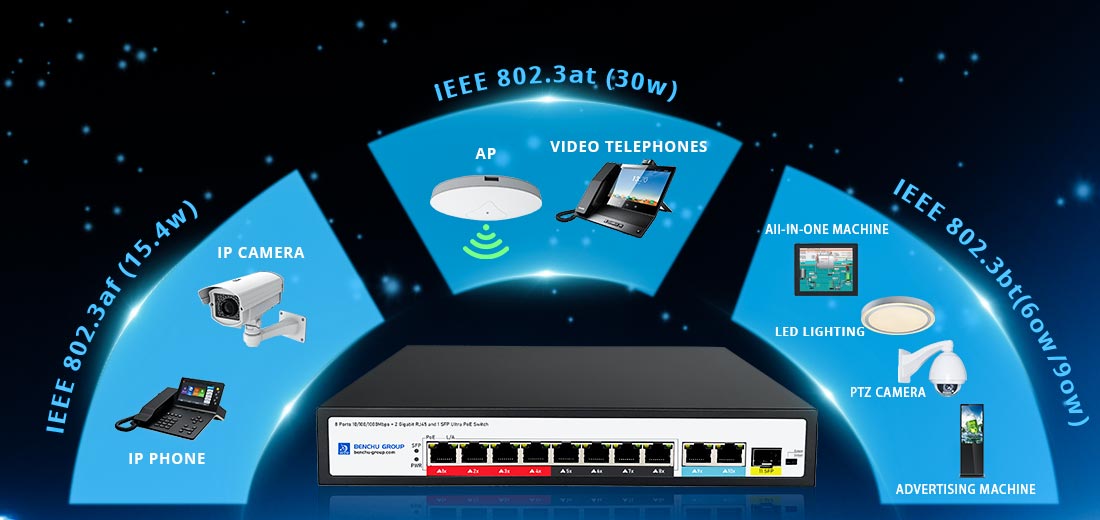
Power over Ethernet (PoE) standards define how power is delivered over Ethernet cables to power networked devices, such as IP cameras, VoIP phones, and wireless access points. The primary PoE standards are IEEE 802.3af, IEEE 802.3at, and IEEE 802.3bt. Each standard outlines the power levels, voltage, and maximum current that can be provided to devices. Here’s a breakdown of the different PoE standards:
1. IEEE 802.3af (PoE)
Introduced: 2003
Power Output per Port: Up to 15.4W at the switch
Available Power for Devices: Up to 12.95W (after accounting for power loss over the cable)
Voltage: 44-57V
Maximum Current: 350mA
Cable Type: Requires Cat5 or higher (Cat5e, Cat6, etc.)
Typical Devices Supported:
--- VoIP phones
--- Basic IP cameras (non-PTZ)
--- Low-power wireless access points
Overview: The IEEE 802.3af standard, commonly known as PoE, provides up to 15.4 watts of power per port. After considering power losses over the Ethernet cable, about 12.95W is available to power the device. This standard is sufficient for low-power devices such as VoIP phones and standard IP cameras but may not provide enough power for advanced devices with higher energy demands.
2. IEEE 802.3at (PoE+)
Introduced: 2009
Power Output per Port: Up to 30W at the switch
Available Power for Devices: Up to 25.5W
Voltage: 50-57V
Maximum Current: 600mA
Cable Type: Requires Cat5 or higher
Typical Devices Supported:
--- Wireless access points with multiple antennas
--- PTZ (Pan-Tilt-Zoom) IP cameras
--- Advanced IP phones with video
--- LED lighting
Overview: IEEE 802.3at, known as PoE+, significantly increased the power delivery capabilities over PoE, providing up to 30W per port, with 25.5W available for devices. This higher power budget makes PoE+ suitable for more demanding devices, such as advanced IP cameras (PTZ cameras), wireless access points, and devices that support video functionality.
3. IEEE 802.3bt (PoE++ or 4-Pair PoE)
Introduced: 2018
Power Output per Port (Type 3): Up to 60W at the switch
Available Power for Devices (Type 3): Up to 51W
Power Output per Port (Type 4): Up to 100W at the switch
Available Power for Devices (Type 4): Up to 71.3W
Voltage (Type 3): 50-57V
Voltage (Type 4): 52-57V
Maximum Current (Type 3): 600mA per pair
Maximum Current (Type 4): 960mA per pair
Cable Type: Requires Cat5e or higher for Type 3 and Cat6 or higher for Type 4 (for optimal performance)
Typical Devices Supported:
--- High-end wireless access points (Wi-Fi 6/6E)
--- High-power PTZ cameras
--- Digital signage
--- Building automation systems (e.g., smart lighting, HVAC controls)
--- Thin client workstations
--- POS (Point of Sale) systems
Overview: IEEE 802.3bt, also known as PoE++ or 4-Pair PoE, further expands the power capacity by using all four pairs of wires in an Ethernet cable to deliver power. This standard has two power levels: Type 3 (up to 60W) and Type 4 (up to 100W). PoE++ is designed to support high-power devices like large digital displays, high-performance wireless access points, and even IoT devices in smart buildings.
Summary of PoE Standards
| Standard | Max Power Output per Port | Max Power Available to Device | Typical Devices Powered | Year Introduced |
| IEEE 802.3af | 15.4W | 12.95W | VoIP phones, standard IP cameras, low-power access points | 2003 |
| IEEE 802.3at | 30W | 25.5W | PTZ IP cameras, advanced access points, video phones | 2009 |
| IEEE 802.3bt (Type 3) | 60W | 51W | High-end WAPs, PTZ cameras, building automation systems | 2018 |
| IEEE 802.3bt (Type 4) | 100W | 71.3W | Digital signage, smart lighting, high-power PoE devices | 2018 |
Choosing the Right PoE Standard for Your Network
--- IEEE 802.3af (PoE): Ideal for networks with low-power devices such as VoIP phones, basic IP cameras, and simple access points.
--- IEEE 802.3at (PoE+): Best suited for medium-power devices like PTZ cameras, advanced access points, and devices requiring more than 15.4W.
--- IEEE 802.3bt (PoE++): Necessary for high-power devices such as Wi-Fi 6 access points, building automation systems, large LED lighting arrays, and other power-hungry equipment.
Make sure to assess the power needs of your connected devices and choose a PoE switch or injector that supports the appropriate standard. For future-proofing, opting for PoE+ or PoE++ switches ensures your network can handle more demanding devices as your infrastructure grows.